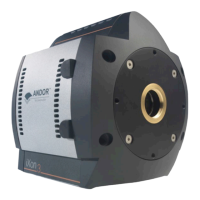Page 22
Features & Functionality
Figure 14 belowshowsS/Nplotsderivedfromthespecicationsoftheback-illuminatediXon3EMCCDsat1MHz
(slowerframerateoperation),readouteitherwithEMGainONoralternativelythroughtheconventionalamplier
(i.e. standard CCD operation). Again, this plot assumes a photon wavelength at which the QE of the sensor is 90%.
Specically this gure applies to 897 and 888 models where the user has the choice of either EMCCD or conventional
ampliers.
At these slower speed operationswhenonehasthechoicetoreadoutasa“conventional”CCDitcanoftenbe
advantageous to do so in order to achieve better signal to noise. Indeed the plots show that the cross-over point is at
~42photons/pixel,belowwhichitisstilladvisedtoreadoutthroughtheEMamplierwithGainapplied.
3.1.4 - Multiplicative Noise Factor & Photon Counting
It is impossible to know the exact gain a detected signal charge traversing the EM gain register will acquire due to the
stochastic nature of the processes which produce EM gain. However it is possible to calculate the probability distribution
function of output charge for a given input charge.
Atreasonablyhighgainlevels(>30)thisuncertaintyintroducesanadditionalnoisecomponentcalledMultiplicative
Noise. This noise source is only present in signal amplifying technologies and is a measure of the uncertainty inherent
to the signal multiplying process. For example, during each transfer of electrons from element to element along the gain
register of the EMCCD, only a small probability exists that the process of impact ionization will produce an extra electron
duringthatstep.Thishappenstobeasmallprobabilitybutwhenexecutedover>590steps,averylargeoverallEM
gain results. However, the downside to this process results from the probabilities! Due to this, there is a statistical
variation in the overall number of electrons generated by the gain register from an initial charge packet. This uncertainty
isquantiedbyaparametercalled“NoiseFactor”anddetailedtheoreticalandmeasuredanalysishasplacedthisNoise
Factor at a value of (or 1.41:1) for EMCCD technology. Note: This noise source is signicantly greater for the Multi
Channel Plate (MCP) of ICCDs than for the gain register of the EMCCD. ICCDs have noise factors typically ranging from
1.5to>2.
So,thisisanadditionalformofnoisethatmustbetakenintoaccountwhencalculatingSignal/Noiseforthesedetectors.
However, one way to better understand the effects of this noise source is in terms of an addition to the shot noise of the
system. Extra multiplicative noise has the same form as shot noise in that each noise type results in an increase in the
variation of number of electrons that are read out of the sensor (under constant uniform illumination).
Figure 14: EM Gain ON vs. Conventional
Amplier signal to noise plots for back-
illuminated iXon3 EMCCDs at 1MHz readout
speed (applies to 897 and 888 models).

